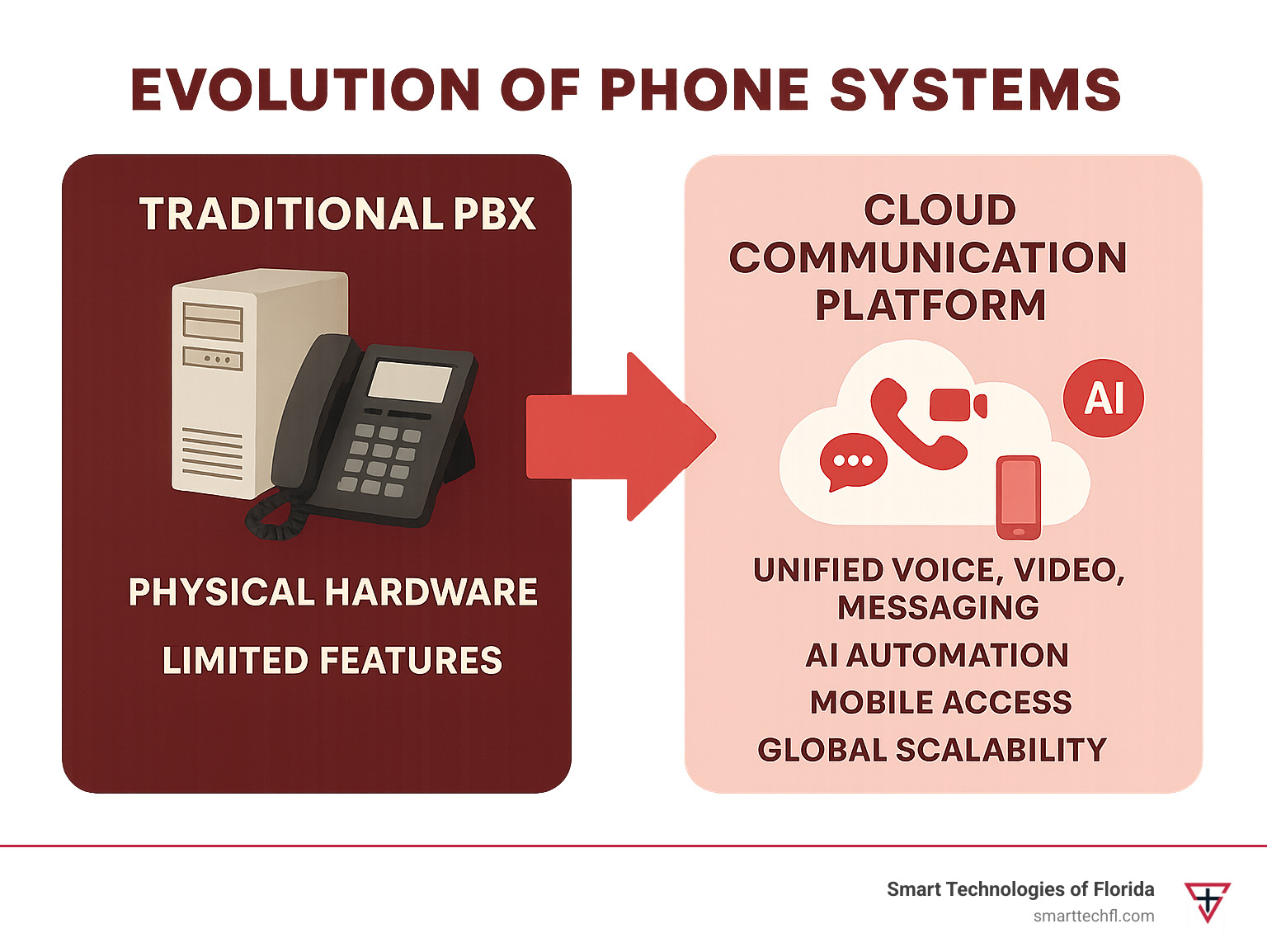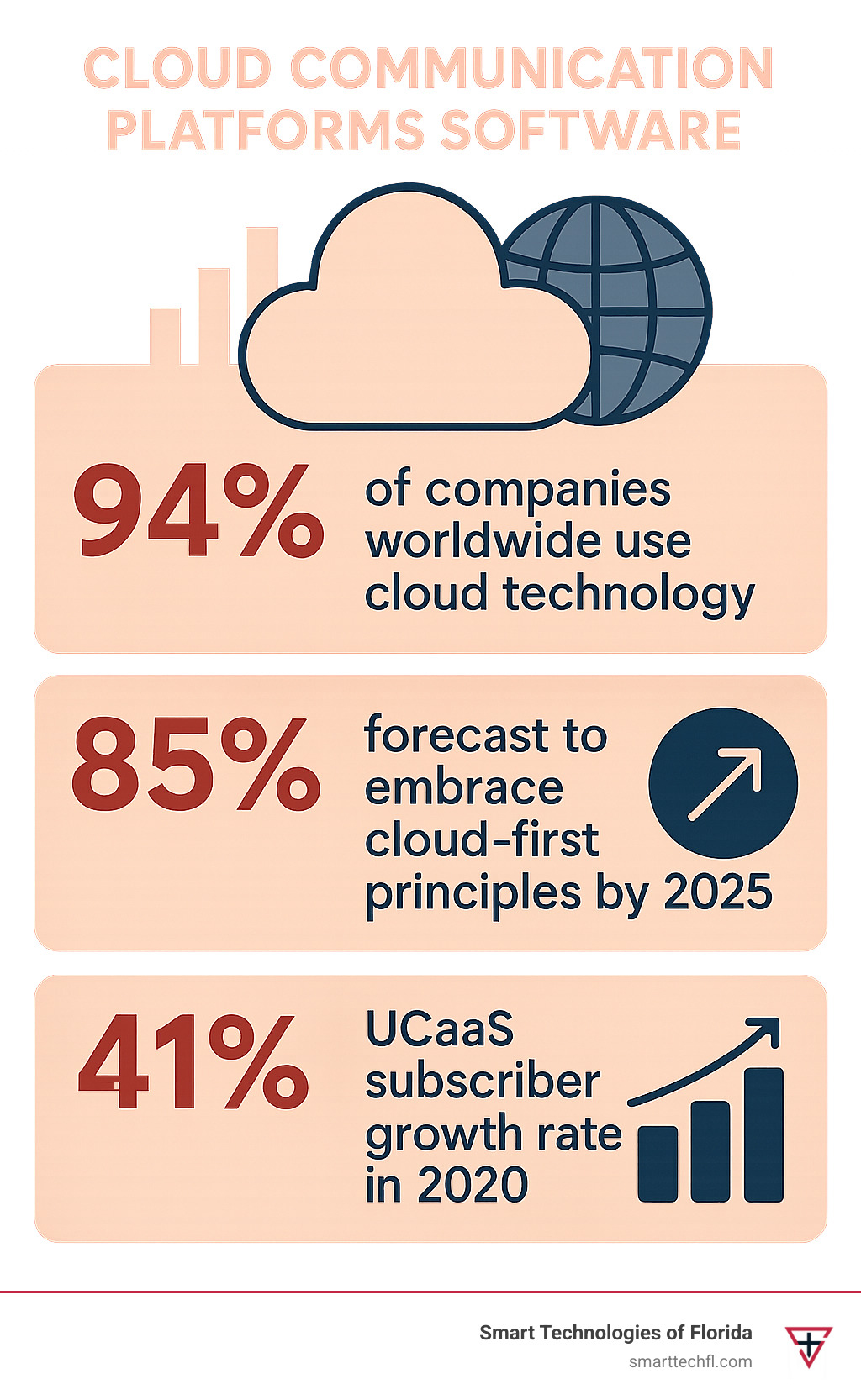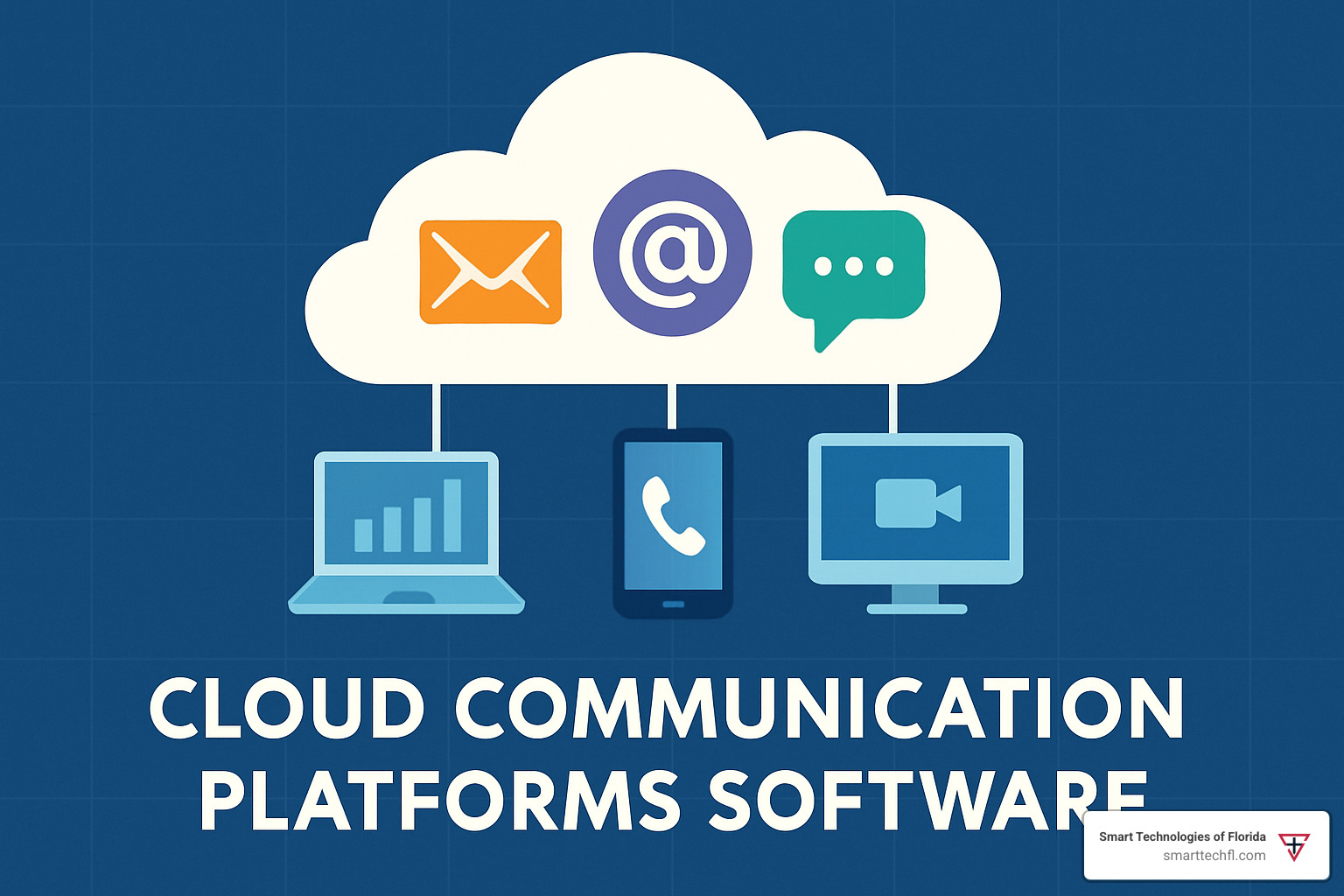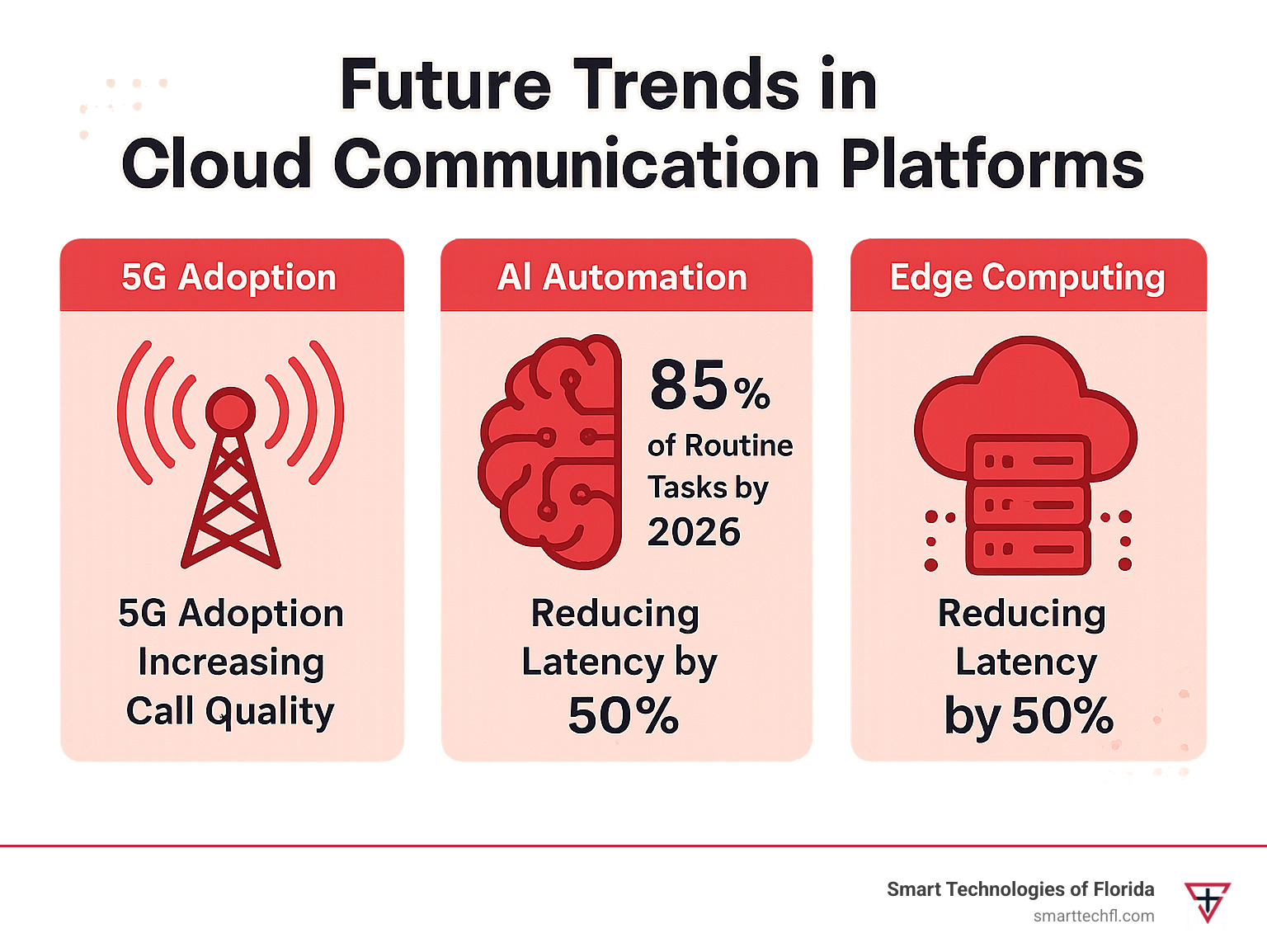Everything You Need to Know About Cloud Communication Platforms Software
Cloud communication platforms software has become the backbone of modern business operations, enabling companies to connect teams, serve customers, and scale operations without the limitations of traditional phone systems.
What is cloud communication platforms software?
- Software-based communication tools hosted on remote servers instead of on-premise hardware
- Unified platforms combining voice calls, video meetings, messaging, and file sharing
- Internet-based systems accessible from any device with an internet connection
- Scalable solutions that grow with your business needs
- Cost-effective alternatives to expensive traditional PBX systems
The shift to cloud communications isn’t just a tech trend—it’s a business necessity. With just 36% of US companies requiring full-time office work (down from 49% in early 2023), businesses need flexible communication tools that work anywhere, anytime.
“Remote working might be down since the pandemic, but hybrid working is still growing strong in 2024,” according to recent industry analysis. This reality has pushed cloud communication platforms from “nice-to-have” to “must-have” for competitive businesses.
Traditional phone systems with their expensive hardware, complex maintenance, and limited flexibility simply can’t keep up. Cloud platforms eliminate these pain points while adding powerful features like AI-powered call routing, real-time analytics, and seamless mobile integration.
For retail businesses especially, these platforms offer omnichannel customer support, automated appointment scheduling, and the ability to turn missed calls into new customers—all while reducing operational costs by up to 30%.

What Is Cloud Communication Platforms Software?
Imagine walking into your office one morning and finding that your bulky phone system has been replaced by something invisible—yet infinitely more powerful. That’s essentially what cloud communication platforms software does for your business. It takes all those tangled wires, expensive hardware boxes, and maintenance headaches and replaces them with smart, internet-based tools that just work.
The beauty of this change lies in its simplicity. Instead of owning and maintaining complicated equipment, you’re accessing professional-grade communication tools through the internet. It’s like the difference between owning a printing press and using a modern copy center—you get better results with far less hassle.
These platforms typically come in two flavors that work hand-in-hand. Communications Platform as a Service (CPaaS) gives tech-savvy businesses the building blocks to create custom solutions, while Unified Communications as a Service (UCaaS) offers ready-made communication suites that most businesses can start using immediately. Think of CPaaS as a custom kitchen renovation and UCaaS as moving into a fully-equipped apartment.
The real magic happens when these systems replace your traditional VoIP setup and virtual PBX with something far more sophisticated. Modern platforms weave together voice calls, video meetings, team messaging, and file sharing into one seamless experience. Your employees can start a conversation in chat, escalate to a video call, and share their screen—all without switching between different apps.
Definition & Key Components
Cloud communication platforms software works because of several key pieces that fit together like a well-designed puzzle. Understanding these components helps explain why these systems are so much more reliable and flexible than traditional phone setups.
Cloud servers form the foundation of everything. Instead of having a phone system sitting in your office closet (probably overheating and collecting dust), all the heavy lifting happens in professional data centers. These facilities have backup power, redundant internet connections, and teams of experts keeping everything running smoothly.
Internet Protocol technology carries your voice and video conversations over the same internet connection you use for email and web browsing. This eliminates the need for separate phone lines while delivering better call quality than many traditional systems.
The softphone applications are where your team actually interacts with the system. These apps turn any computer, tablet, or smartphone into a powerful business phone. Your sales rep can take calls on their laptop at a coffee shop, and customers will never know they’re not at their desk.
APIs might sound technical, but they’re simply connectors that let your communication platform talk to your other business tools. When a customer calls, their information automatically pops up from your CRM. When someone leaves a voicemail, it gets transcribed and emailed to you. These connections eliminate the constant app-switching that slows down your team.
Omnichannel capabilities mean your customers can reach you however they prefer—phone call, text message, email, or chat—and your team sees the complete conversation history regardless of how the customer chooses to communicate.
How It Works
The behind-the-scenes operation of cloud communication platforms software is surprisingly neat. When your customer makes a call, they’re not just connecting to your phone—they’re tapping into a global network designed for reliability and performance.
Data centers strategically located around the world ensure that calls connect quickly and clearly. These aren’t just server rooms—they’re fortress-like facilities with multiple internet connections, backup generators, and security systems that would make a bank jealous.
SIP trunking handles the technical details of connecting your business calls to the global phone network. Instead of physical phone lines running to your building, everything flows through your internet connection. This means you can add new phone numbers instantly or route calls to different locations without a technician visit.
WebRTC technology enables something pretty amazing—customers can click a button on your website and instantly start a voice or video call without downloading any software. It’s like having a virtual front door that’s always open.
The redundancy systems are what make cloud platforms more reliable than traditional phone systems. If one server has issues, another immediately takes over. If an entire data center goes offline (extremely rare), traffic automatically routes to backup facilities. This is why many businesses experience better phone service after switching to the cloud.
Auto-scaling means the system automatically adjusts to handle busy periods. Black Friday rush? Holiday sales surge? The platform seamlessly adds resources to ensure your phones keep ringing and your customers get through.
Core Features You Should Expect
Modern cloud communication platforms software should feel less like using a phone system and more like having a communication superpower. The voice and video calling capabilities often surpass what you’d get from traditional systems, with crystal-clear HD quality and intelligent features like automatic call recording and real-time transcription.
Team chat and messaging transforms how your staff collaborates. Instead of playing phone tag or cluttering email inboxes, teams can have organized conversations that include file sharing, screen captures, and quick video calls when needed. It’s like having a virtual office space where everyone can collaborate naturally.
Screen sharing and collaboration tools make remote support and training incredibly effective. Your tech support team can see exactly what a customer is experiencing, or your trainer can guide new employees through software step-by-step, regardless of where anyone is located.
The analytics dashboard turns your communication system into a business intelligence tool. You’ll see patterns in call volume, identify peak service times, track response speeds, and measure customer satisfaction. This data helps you staff appropriately and identify opportunities to improve service.
AI-powered features like automatic transcription and sentiment analysis work quietly in the background, making your team more efficient. Calls get transcribed automatically, important messages get flagged, and the system learns to route calls to the right person based on the caller’s needs and past interactions.
Types, Benefits, and Industry Use Cases
The beauty of cloud communication platforms software lies in its flexibility—there’s no one-size-fits-all approach. Just like choosing the right car for your needs, selecting the right deployment model depends on your business requirements, security needs, and budget.

Types of Deployment Models for Cloud Communication Platforms Software
Think of deployment models as different ways to access the same powerful communication tools. Public cloud deployments are like staying at a well-managed hotel—you share the infrastructure with other guests, but everything is maintained professionally and costs much less. This model works perfectly for most small to medium businesses that want enterprise-grade features without the headache of managing complex systems.
Private cloud solutions are more like owning your own building. You get complete control and privacy, but you also pay more for that exclusivity. Organizations with strict security requirements—like law firms handling sensitive cases or healthcare providers managing patient data—often choose this route.
Hybrid cloud gives you the best of both worlds, like having a home office plus access to shared workspace. You can keep your most sensitive communications on private infrastructure while using public cloud for everyday operations. This approach lets you balance security concerns with cost efficiency.
Multi-cloud strategies spread your communication services across different providers, reducing the risk of putting all your eggs in one basket. Some businesses use one provider for voice services and another for video conferencing, choosing each based on their specific strengths.
Edge computing brings communication services closer to your actual location through distributed data centers. It’s like having a local branch of your favorite store instead of ordering everything from across the country—everything works faster and more smoothly.
Business Benefits & ROI
The financial impact of switching to cloud communication platforms software often surprises business owners. Most organizations see cost savings of 30-50% compared to traditional phone systems, but the real value goes much deeper than the monthly bill.
Instead of massive upfront investments in hardware that becomes outdated quickly, you pay predictable monthly operational expenses that scale with your actual usage. It’s like switching from buying expensive equipment to renting exactly what you need, when you need it.
Flexibility becomes your secret weapon. Adding new team members takes minutes instead of waiting weeks for phone line installations. Seasonal businesses can easily scale up during busy periods and scale back down afterward, paying only for what they actually use.
Uptime guarantees of 99.99% or higher mean your communication system works more reliably than most traditional phone systems. Cloud providers invest millions in redundant infrastructure that would be impossible for individual businesses to maintain.
The real game-changer is business agility. When your team can communicate effectively from anywhere, decisions happen faster and customer service improves dramatically. Companies consistently report that their responsiveness and competitiveness improve significantly after making the switch.
For a deeper dive into these advantages, our comprehensive guide on cloud communication solutions explores the specific benefits for different business types.
Collaboration, Productivity & Remote-Work Power
The workplace has fundamentally changed, and cloud communication platforms software makes this new reality work beautifully. With 62% of companies in the US now offering work location flexibility, having communication tools that work everywhere isn’t just convenient—it’s essential for staying competitive.
Mobile applications ensure your team stays connected whether they’re in the office, working from home, or traveling for business. These aren’t watered-down versions of the desktop experience—they provide full functionality that keeps productivity high regardless of location.
BYOD support lets employees use their personal devices for work communications while maintaining enterprise-level security. This approach saves money on hardware while giving employees the flexibility to use devices they’re already comfortable with.
Global accessibility means time zones become less of a barrier. Team members can collaborate through asynchronous messaging, share recorded video updates, and schedule meetings that work for everyone involved.
Hot-desking capabilities support modern flexible office arrangements. When employees don’t have assigned desks, their phone number and personal settings follow them to whatever device or location they’re using that day.
Industry Success Stories & Vertical Wins
Different industries find unique ways to leverage cloud communication platforms software for their specific challenges and opportunities.
Healthcare organizations have transformed patient care through telemedicine features, automated appointment reminders, and secure patient communications. One major health system saw patient satisfaction scores jump 42% after implementing cloud communications, largely due to improved accessibility and reduced wait times.
Retail businesses excel with omnichannel customer support that meets shoppers wherever they are. Automated order notifications keep customers informed, while intelligent call routing connects them with representatives who already know their purchase history. SMS marketing campaigns through these platforms consistently generate three times more conversions than traditional methods.
Financial services rely heavily on two-factor authentication, encrypted communications, and built-in compliance features. One bank achieved remarkable results by integrating WhatsApp into their customer service strategy, securing 41% of insurance renewals through this more personal, convenient channel.
Education institutions use virtual classrooms, streamlined parent-teacher conferences, and campus-wide emergency notifications. The ability to quickly scale video capacity proved invaluable during remote learning transitions, but these tools continue providing value for hybrid and in-person education models.
Cloud Communication Platforms Software vs. Traditional Systems
The gap between modern cloud communication platforms software and traditional phone systems has become so wide that it’s like comparing a smartphone to a rotary phone. Both make calls, but that’s where the similarities end.

Traditional PBX systems served businesses well for decades, but they’ve become expensive anchors in today’s fast-moving business world. These legacy systems require massive upfront investments, ongoing maintenance headaches, and leave businesses vulnerable when disasters strike.
Cloud communication platforms software flips this entire model on its head. Instead of owning and maintaining complex hardware, businesses access enterprise-grade communication tools through the internet. It’s the difference between building your own power plant versus plugging into the electrical grid.
| Feature | Traditional PBX | Cloud Communication Platforms |
|---|---|---|
| Initial Investment | $50,000-$200,000+ | $0 setup costs |
| Monthly Costs | $40-80 per user | $15-50 per user |
| Deployment Time | 2-6 months | 1-7 days |
| Maintenance | Dedicated IT staff required | Provider managed |
| Disaster Recovery | Expensive backup systems | Built-in redundancy |
| Mobile Integration | Limited or expensive add-ons | Native mobile apps |
| Scalability | Hardware limitations | Instant scaling |
| Updates | Manual, costly upgrades | Automatic updates |
Key Differences That Matter
Hardware elimination represents the most liberating change for businesses. Traditional systems turn office closets into mini data centers filled with humming servers, tangled cables, and blinking lights that someone needs to understand and maintain. Cloud platforms make all that equipment disappear, freeing up valuable office space and eliminating the constant worry about hardware failures.
Pay-as-you-go pricing transforms communication costs from unpredictable capital expenses into manageable monthly bills. Instead of writing a massive check upfront and crossing your fingers that the system will last five years, businesses pay for what they actually use. It’s like switching from buying a car to using ride-sharing—you get transportation without the maintenance, insurance, and depreciation headaches.
Rapid deployment means new offices can be making calls before the furniture arrives. Traditional phone systems require scheduling technicians, waiting for equipment deliveries, and coordinating complex installations. With cloud platforms, employees can download an app and start communicating immediately.
Global reach comes built into every cloud platform, enabling seamless communication across continents at local calling rates. Traditional systems often treat international communication as an expensive afterthought, requiring additional hardware and costly calling plans.
Pricing Models & Scalability Options
Understanding how cloud communication platforms software pricing works helps businesses plan budgets and avoid surprises. Most providers offer per-user pricing that ranges from $15 for basic calling features to $50 for comprehensive communication suites. This predictable model makes budgeting simple and scales naturally as teams grow.
Consumption-based pricing appeals to businesses with variable communication needs. Instead of paying for unused capacity, these models charge based on actual minutes, messages, or data transferred. Seasonal businesses particularly benefit from this flexibility.
Tiered feature packages let businesses choose exactly what they need without paying for bells and whistles they’ll never use. Basic tiers might include essential calling and messaging, while premium packages add video conferencing, advanced analytics, and AI-powered features.
Burst capacity provides a safety net for unexpected demand spikes. Whether it’s a viral marketing campaign driving call volume or a crisis requiring emergency communication, cloud platforms can instantly scale without long-term commitments.
For businesses evaluating the financial impact of switching to cloud communications, our detailed analysis in Cloud Voice Services Cost & Benefits Explained provides real-world cost comparisons and ROI calculations.
Security, Compliance & Reliability Essentials
Security concerns often top the list when businesses consider moving to the cloud, but modern cloud communication platforms software typically provides better protection than traditional systems. The difference lies in resources and expertise—cloud providers invest millions in security infrastructure that individual businesses couldn’t afford.
Encryption protects every conversation, message, and file transfer using the same standards that banks use for financial transactions. Traditional phone systems often transmit calls in the clear, making them vulnerable to eavesdropping.
Multi-factor authentication ensures that stolen passwords can’t compromise communication systems. This extra security layer has become essential as cyber threats evolve and remote work increases attack surfaces.
SOC monitoring provides round-the-clock threat detection and response from dedicated security teams. These professionals focus exclusively on identifying and stopping attacks, following proven SOC best practices that most businesses couldn’t implement independently.
Compliance certifications remove regulatory headaches for businesses in healthcare, finance, and other regulated industries. Leading platforms maintain HIPAA compliance for healthcare communications, PCI DSS certification for payment processing, and GDPR compliance for data protection.
Reliability guarantees often exceed what traditional systems achieve, with uptime commitments of 99.99% or higher. Cloud providers build redundancy into every component, automatically switching to backup systems when problems occur. It’s like having multiple backup generators that kick in instantly, except for your entire communication system.
Choosing & Future-Proofing Your Cloud Communication Platforms Software
Selecting the right cloud communication platforms software feels like choosing a business partner—because that’s exactly what you’re doing. This decision will shape how your team collaborates, how customers experience your service, and how smoothly your business operates for years to come.
The key is thinking beyond today’s needs. Your current team might be small, but what happens when you double in size? What if you expand to new locations or need to support remote workers? The best platforms grow with you seamlessly.

Seamless Integration With Business Tools
Your cloud communication platforms software shouldn’t live in isolation—it should play nicely with all your existing business tools. Think of it as building a digital ecosystem where everything talks to everything else.
CRM integration transforms how your sales team works. Instead of juggling multiple screens, customer information appears automatically during calls. Sales reps can click a button to dial prospects directly from customer records. This simple connection often boosts sales productivity by 20-30% because it eliminates those annoying little time-wasters that add up throughout the day.
ERP system connections streamline your entire operation. When a customer calls about an order, your team can instantly see shipping status, inventory levels, and payment history. No more putting customers on hold while someone “looks that up.”
Helpdesk integration creates a beautiful customer service flow. Missed calls automatically become support tickets. Technical issues get routed to the right specialists. Every conversation becomes part of the customer’s history, so they never have to repeat their story.
Low-code connectors are game-changers for businesses using specialized software. You don’t need a computer science degree to connect your communication platform to industry-specific tools. These visual, drag-and-drop interfaces make integration accessible to anyone.
For businesses with unique requirements, open APIs provide unlimited possibilities. Your IT team (or ours) can create custom connections that perfectly match your workflow.
AI, Automation & Emerging Innovations
Here’s where things get exciting. Cloud communication platforms software is becoming genuinely intelligent, handling routine tasks so your team can focus on what humans do best—building relationships and solving complex problems.
Chatbots and virtual assistants have evolved far beyond those frustrating “press 1 for…” systems. Modern AI can handle detailed conversations, qualify leads, and provide helpful information 24/7. The best part? They’re getting so good that many customers prefer them for simple questions because they get instant answers.
Sentiment analysis works like having a supervisor who never sleeps. The system monitors conversations in real-time, detecting when customers sound frustrated or upset. It can alert managers immediately so they can jump in before small issues become big problems.
Intelligent call routing learns your business better than most employees. It tracks which agents excel with certain types of calls and automatically sends customers to the person most likely to help them. Over time, this creates better experiences for everyone.
Predictive analytics turn your communication data into a crystal ball. The system identifies patterns that help you forecast busy periods, optimize staffing, and even predict what customers might need before they ask.
What to Look For During Vendor Selection
Shopping for communication platforms can feel overwhelming, but focusing on these key areas will guide you to the right choice.
Service Level Agreements (SLAs) aren’t just legal documents—they’re promises about how your business will run. Look for uptime guarantees of 99.9% or higher, with real financial penalties if the provider doesn’t deliver. If they’re not confident enough to put money behind their promises, that tells you something.
Compliance certifications matter more than you might think. Healthcare businesses absolutely need HIPAA compliance. Financial services require additional security certifications. Getting this wrong isn’t just inconvenient—it can be expensive and damaging to your reputation.
Migration support separates professional providers from the rest. Moving from your current system should feel smooth and supported, not like jumping off a cliff. Good providers offer data transfer help, comprehensive training, and the option to run both systems temporarily during the transition.
User experience testing through free trials reveals how the platform actually feels to use daily. Features look great on paper, but if your team struggles with the interface, productivity suffers. Always test before you commit.
Change management support acknowledges that technology is only half the battle. The best providers help with training, implementation planning, and ongoing support to ensure your team accepts the new system enthusiastically.
The Road Ahead: Market Outlook to 2030
The future of cloud communication platforms software is arriving faster than most businesses realize, and it’s bringing capabilities that sound like science fiction.
5G networks will transform what’s possible with business communications. Imagine video calls so clear they feel like looking through a window, real-time language translation during international calls, and augmented reality meetings where remote participants feel physically present.
Edge computing brings processing power closer to where you actually work, dramatically improving performance. This means faster response times, better call quality, and new features like real-time AI analysis of customer conversations.
Immersive AR and VR meetings will create virtual collaboration spaces that feel remarkably like being in the same room. Teams will manipulate 3D models together, conduct training in simulated environments, and hold meetings in virtual spaces designed for productivity.
Sustainability features address growing environmental concerns while reducing costs. Optimized routing reduces energy consumption, efficient data centers minimize carbon footprints, and reduced travel needs help businesses meet environmental goals.

The businesses that start preparing for these changes now will have significant advantages over those who wait. The good news? Choosing the right platform today sets you up perfectly for tomorrow’s innovations.
Frequently Asked Questions about Cloud Communication Platforms Software
How does cloud communication ensure call quality and uptime?
The secret behind reliable cloud communication platforms software lies in something called redundancy—basically, having backups for your backups. When you make a call through a cloud platform, you’re not relying on a single server sitting in someone’s basement. Instead, your call travels through a network of data centers spread across different geographic locations.
Think of it like having multiple routes to get to work. If one road is blocked, you automatically take another route without even thinking about it. Cloud communication platforms software works the same way—if one server goes down, another one instantly takes over.
The technical magic happens through Quality of Service (QoS) protocols that treat your voice and video calls like VIP passengers on the internet highway. These protocols push your communication traffic to the front of the line, ensuring crystal-clear conversations even when everyone in the office is streaming videos during lunch break.
Most enterprise providers guarantee 99.99% uptime, which sounds impressive until you realize what it actually means—less than an hour of downtime per entire year. That’s often better reliability than the power grid in many areas. They achieve this through continuous monitoring systems that watch for problems 24/7 and fix issues before users even notice them.
What’s the difference between CPaaS and UCaaS?
This is one of those questions where the acronyms make things sound more complicated than they really are. Let’s break it down with a simple analogy.
CPaaS (Communications Platform as a Service) is like buying ingredients and cooking tools. You get APIs, development resources, and building blocks to create exactly the communication features your business needs. It’s perfect if you have specific requirements or want to integrate communication directly into your existing software.
UCaaS (Unified Communications as a Service) is like ordering a complete meal from your favorite restaurant. You get voice calling, video meetings, team chat, file sharing, and collaboration tools all bundled together in one ready-to-use package.
Most businesses start with UCaaS because it gets them up and running quickly. You can have your entire team making calls and holding video meetings within hours, not weeks. CPaaS makes more sense for companies that need custom features or have unique integration requirements.
Some organizations use both approaches—UCaaS for daily communication needs and CPaaS for specialized applications like customer service chatbots or automated appointment reminders.
How can small businesses control costs when scaling?
This might be the most important question for growing businesses, and the good news is that cloud communication platforms software was practically designed with cost control in mind.
Pay-as-you-go pricing means you’re not paying for empty seats at the table. If you need communication tools for five people this month and fifteen people next month, you only pay for what you actually use. No more buying expensive phone system capacity that sits unused for years.
Flexible user management lets you add team members as you hire them and remove access when people leave—all without cancellation fees or long-term contracts. Many platforms let you make these changes through a simple web interface that takes minutes, not phone calls to customer service.
Feature-based pricing tiers mean you can start with basic calling and messaging, then add video conferencing, advanced analytics, or AI features as your business grows and can justify the additional investment. It’s like upgrading your car features as your budget allows, rather than buying a luxury vehicle from day one.
Usage monitoring dashboards help you track exactly where your communication dollars are going. You might find that most of your costs come from international calling and decide to negotiate better rates, or realize that you’re paying for features nobody actually uses.
The beauty of cloud platforms is that seasonal scaling becomes effortless. Retail businesses can temporarily add capacity for holiday shopping seasons, while service companies can scale up during busy periods without permanent cost increases.
Conclusion
Cloud communication platforms software represents more than just a technology upgrade—it’s your gateway to business change in an increasingly digital world. Think of it as trading in an old flip phone for a smartphone, except the impact touches every corner of your organization.
The numbers don’t lie. With 94% of companies worldwide already using cloud technology and 85% expected to accept cloud-first principles by 2025, we’re not talking about a future trend anymore. We’re talking about today’s business reality.
Here’s what makes this shift so powerful: businesses consistently see 30% cost savings, dramatically improved customer satisfaction, and teams that collaborate like never before. Whether you’re a busy restaurant trying to manage reservations or a growing law firm coordinating across multiple offices, these platforms level the playing field.
The human element matters most. At Smart Technologies of Florida, we’ve spent 23 years helping businesses steer digital change, and we’ve learned something important: the best technology in the world fails without the right people-centered approach. That’s why we focus on understanding your unique goals first, then building solutions that actually work for your team.
Your customers expect seamless communication. They want to reach you on their terms—whether that’s a quick text, a video call, or traditional phone conversation. Cloud communication platforms software makes this possible without the complexity and cost of traditional systems.
The future is already knocking at your door. AI assistants are handling routine calls, 5G networks are enabling crystal-clear video meetings from anywhere, and smart routing is connecting customers to exactly the right person every time. The businesses that thrive won’t be the ones with the biggest budgets—they’ll be the ones that accept these tools strategically.
Ready to transform how your business connects? Every day you wait is another day your competitors might be getting ahead. But here’s the good news: implementing the right solution doesn’t have to be overwhelming when you have the right partner.
Explore our comprehensive Business Communication Solutions and find how Smart Technologies of Florida can guide your journey to cloud-powered success. Let’s build a communication strategy that grows with your business and empowers your team to achieve more than you thought possible.
Your digital change starts with a single conversation. Let’s make it count.












